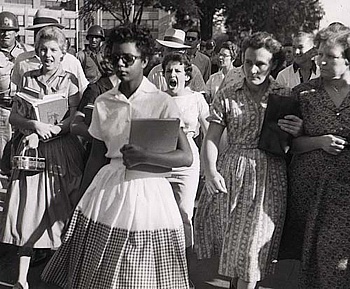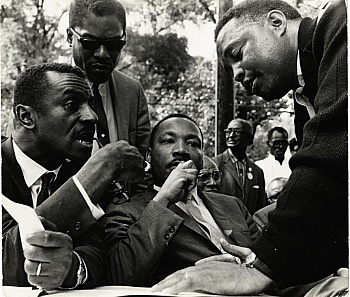- Actualité
Charles Moore s'est éteint à l'âge de 79 ans
 Décès du photographe américain Charles Moore, à l'âge de 79 ans, il avait suivi le mouvement des droits civiques aux Etats-Unis.
Cette information à été confirmé par John Edgley, des services d'incinération Edgley de West Palm Beach, en Floride.
Selon le "Times Daily" de Florence, en Alabama, Charles Moore avait commencé à couvrir le mouvement des droits civiques quand Martin Luther King avait été arrêté à Montgomery en 1958. Au cours des années suivantes, le photographe originaire de l'Alabama prit certains des clichés les plus marquants de la lutte.
Il travailla la majeure partie de sa carrière pour le magazine Life.
En 1991, une collection de ses photogr...
Décès du photographe américain Charles Moore, à l'âge de 79 ans, il avait suivi le mouvement des droits civiques aux Etats-Unis.
Cette information à été confirmé par John Edgley, des services d'incinération Edgley de West Palm Beach, en Floride.
Selon le "Times Daily" de Florence, en Alabama, Charles Moore avait commencé à couvrir le mouvement des droits civiques quand Martin Luther King avait été arrêté à Montgomery en 1958. Au cours des années suivantes, le photographe originaire de l'Alabama prit certains des clichés les plus marquants de la lutte.
Il travailla la majeure partie de sa carrière pour le magazine Life.
En 1991, une collection de ses photogr... - Exposition
exhibition : « Righting Civil Wrongs » at Keith de Lellis gallery
 The exhibition will show vintage photographs of the struggle for racial equality. Among the photographers, you can discover Bob Adelman, James Karales, Charles Moore or Flip Schulke.
For further information : http://www.keithdelellisgallery.com/
James Karales - Bobby Simmons on the Selma to Montgomery march - 1965
Flip Schulke - The climatic moment of Martin Luther King, Jr.'s "I have a dream" speech, when he declared,
"Free at last! Free at last! Thank god almighty, we are free at last" - August 28, 1963
James Karales - "Get Right With God" sign on Highway 80 on the Selma to Montgomery march - 1965
...
The exhibition will show vintage photographs of the struggle for racial equality. Among the photographers, you can discover Bob Adelman, James Karales, Charles Moore or Flip Schulke.
For further information : http://www.keithdelellisgallery.com/
James Karales - Bobby Simmons on the Selma to Montgomery march - 1965
Flip Schulke - The climatic moment of Martin Luther King, Jr.'s "I have a dream" speech, when he declared,
"Free at last! Free at last! Thank god almighty, we are free at last" - August 28, 1963
James Karales - "Get Right With God" sign on Highway 80 on the Selma to Montgomery march - 1965
... - Exposition
Exposition : Human rights, human wrongs
 The Photographers' Gallery in collaboration with The Ryerson Image Centre and Autograph ABP present Human Rights Human Wrongs.
Human Rights Human Wrongs features more than 200 original press prints, drawn from the prestigious Black Star collection of twentieth century photoreportage.
© Hilmar Pabel - Czechoslovakia Invasion, Prague, August 21 1968
The exhibition explores what role such images play in helping us understand the case for human rights, and further addresses the legacy of how photographs have historically functioned in raising awareness of international conflict.
The exhibition spans a time frame from 1945 until the early 90s and examines the major political upheavals, conflict, war and struggles against racism and colonisation that became especially urgent following World War II. I...
The Photographers' Gallery in collaboration with The Ryerson Image Centre and Autograph ABP present Human Rights Human Wrongs.
Human Rights Human Wrongs features more than 200 original press prints, drawn from the prestigious Black Star collection of twentieth century photoreportage.
© Hilmar Pabel - Czechoslovakia Invasion, Prague, August 21 1968
The exhibition explores what role such images play in helping us understand the case for human rights, and further addresses the legacy of how photographs have historically functioned in raising awareness of international conflict.
The exhibition spans a time frame from 1945 until the early 90s and examines the major political upheavals, conflict, war and struggles against racism and colonisation that became especially urgent following World War II. I...
Modifier l'image
 Décès du photographe américain Charles Moore, à l'âge de 79 ans, il avait suivi le mouvement des droits civiques aux Etats-Unis.
Cette information à été confirmé par John Edgley, des services d'incinération Edgley de West Palm Beach, en Floride.
Selon le "Times Daily" de Florence, en Alabama, Charles Moore avait commencé à couvrir le mouvement des droits civiques quand Martin Luther King avait été arrêté à Montgomery en 1958. Au cours des années suivantes, le photographe originaire de l'Alabama prit certains des clichés les plus marquants de la lutte.
Il travailla la majeure partie de sa carrière pour le magazine Life.
En 1991, une collection de ses photogr...
Décès du photographe américain Charles Moore, à l'âge de 79 ans, il avait suivi le mouvement des droits civiques aux Etats-Unis.
Cette information à été confirmé par John Edgley, des services d'incinération Edgley de West Palm Beach, en Floride.
Selon le "Times Daily" de Florence, en Alabama, Charles Moore avait commencé à couvrir le mouvement des droits civiques quand Martin Luther King avait été arrêté à Montgomery en 1958. Au cours des années suivantes, le photographe originaire de l'Alabama prit certains des clichés les plus marquants de la lutte.
Il travailla la majeure partie de sa carrière pour le magazine Life.
En 1991, une collection de ses photogr... The exhibition will show vintage photographs of the struggle for racial equality. Among the photographers, you can discover Bob Adelman, James Karales, Charles Moore or Flip Schulke.
For further information : http://www.keithdelellisgallery.com/
James Karales - Bobby Simmons on the Selma to Montgomery march - 1965
Flip Schulke - The climatic moment of Martin Luther King, Jr.'s "I have a dream" speech, when he declared,
"Free at last! Free at last! Thank god almighty, we are free at last" - August 28, 1963
James Karales - "Get Right With God" sign on Highway 80 on the Selma to Montgomery march - 1965
...
The exhibition will show vintage photographs of the struggle for racial equality. Among the photographers, you can discover Bob Adelman, James Karales, Charles Moore or Flip Schulke.
For further information : http://www.keithdelellisgallery.com/
James Karales - Bobby Simmons on the Selma to Montgomery march - 1965
Flip Schulke - The climatic moment of Martin Luther King, Jr.'s "I have a dream" speech, when he declared,
"Free at last! Free at last! Thank god almighty, we are free at last" - August 28, 1963
James Karales - "Get Right With God" sign on Highway 80 on the Selma to Montgomery march - 1965
... The Photographers' Gallery in collaboration with The Ryerson Image Centre and Autograph ABP present Human Rights Human Wrongs.
Human Rights Human Wrongs features more than 200 original press prints, drawn from the prestigious Black Star collection of twentieth century photoreportage.
© Hilmar Pabel - Czechoslovakia Invasion, Prague, August 21 1968
The exhibition explores what role such images play in helping us understand the case for human rights, and further addresses the legacy of how photographs have historically functioned in raising awareness of international conflict.
The exhibition spans a time frame from 1945 until the early 90s and examines the major political upheavals, conflict, war and struggles against racism and colonisation that became especially urgent following World War II. I...
The Photographers' Gallery in collaboration with The Ryerson Image Centre and Autograph ABP present Human Rights Human Wrongs.
Human Rights Human Wrongs features more than 200 original press prints, drawn from the prestigious Black Star collection of twentieth century photoreportage.
© Hilmar Pabel - Czechoslovakia Invasion, Prague, August 21 1968
The exhibition explores what role such images play in helping us understand the case for human rights, and further addresses the legacy of how photographs have historically functioned in raising awareness of international conflict.
The exhibition spans a time frame from 1945 until the early 90s and examines the major political upheavals, conflict, war and struggles against racism and colonisation that became especially urgent following World War II. I...